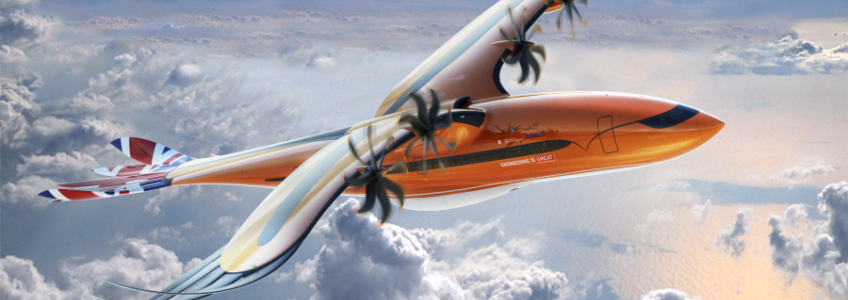Image Credit: Airbus
Animals have long-inspired innovative engineering designs as they’ve evolved perfectly, as nature intended. This provides the ideal solution to environmental challenges, something European manufacturer, Airbus, hopes to achieve as they revealed a brand new concept hybrid-electric aircraft.
Liam Fox, UK Secretary of State for International Trade, unveiled the “Bird of Prey” concept at the Royal International Air Tattoo air show last month. At first glance, it is evident that this new hybrid-electric aircraft got its inspiration eagles, hawks and other aerial predators. Airbus revealed this new concept aircraft with the intention of inspiring the next-generation of aeronautical engineers.
According to Martin Aston, a senior manager at Airbus: “Our ‘Birds of Prey’ is designed to be an inspiration to young people and create a ‘wow’ factor that will help them consider an exciting career in the crucially-important aerospace sector.”
Hybrid-Electric Aircraft Technology
The hybrid-electric aircraft would be a turbo-propeller plane with design cues from eagles and falcons. It features individually controlled feathers on the wings and tail to allow for more precise flight control. The plane also includes a blended wing into the fuselage mimicking the sweeping arch of predatory birds.
A statement on Airbus website sums it up perfectly: “Inspired by efficient mechanics of a bird, it has wing and tail structures that mimic those of a bird of prey, while featuring individually controlled feathers that provide active flight control.”
In theory, the aircraft would be able to carry up to 80 passengers and burn 30%-50% less fuel than today’s aircraft. While unveiled at the Royal International Air Tattoo at RAF Fairford, the hybrid-electric aircraft will not go into production. In addition to sparking interest in young people, it also marks the 50th anniversary of Airbus.
The Future Of Aviation
Although the design does not represent an actual aircraft concept, it is roughly based on either existing or emerging aerospace technologies. Airbus mentioned biomimicry, which is defined as “the design and production of materials, structures and systems inspired by nature”.
It may be a far cry from development and some may consider it far-fetched but Airbus is not alone in trying to find a better, more sustainable solution to traditional aeroplane wings. Fact is, a team of NASA researchers have been working on a new type of flexible wing that transforms as it flies.
This particular concept wing is about 14 feet (4 meters) wide and constructed from thousands of reinforced 3D-printed polyetherimide units. All the components fit together to function similarly to how a bird’s wing flap to create the necessary elevation and propulsion.
Related Article: ‘UK’s Bio-Electric Hybrid Aircraft’
More Sustainable Flight
Sir Brian Burridge, chief executive of the Royal Aeronautical Society said, “Birds in flight have captured the imagination for centuries. The very first engineers looked to nature to work out how to emulate flight, and now the Airbus Bird of Prey concept will play an important role in inspiring the engineers of tomorrow. It is essential that we spark fascination and excitement in the coming generations to attract them towards pioneering sustainable advances for the future of aviation.”
He continued by stating that, “One of the priorities for the entire industry is how to make aviation more sustainable – making flying cleaner, greener and quieter than ever before. We know from our work on the Airbus A350 passenger jet that biomimicry, literally learning from the genetics of animals, that nature has some of the best lessons we can learn about design.”
The Bird of Prey Hybrid-Electric Aircraft Imitative
Several agencies and organisations support the Bird of Prey initiative including:
- The GREAT Britain campaign
- Royal Aeronautical Society
- Air League
- Institution of Engineering and Technology
- Aerospace Technology Institute
Final Thoughts
While it’s certainly incredibly interesting, it will probably take some time before we actually see such a hybrid-electric aircraft. However, there have been tremendous biomimicry research and development thus far proving rather effective with drones or UAVs.
If you liked this article, please follow our weekly blog for more interesting stories on engineering, manufacturing and technology. We have been in the fabricating and precision engineering business for more than 20 years serving various sectors. This includes rail, oil and energy, aerospace, automotive, defence and construction among others.
Get in touch with our team of experts if you need help fabricating a simple or complex product with challenging requirements. We can manufacture to very unique requirements, whether it’s a one-off or a large batch order.


Recent Comments